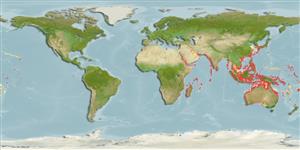Common names from other countries
Environment: milieu / climate zone / depth range / distribution range
Ecologie
; diepteverspreiding 0 - 50 m (Ref. 348). Tropical; 35°N - 37°S, 29°E - 154°W
Indo-West Pacific: from East and southeast Africa, including Madagascar, Mauritius Island, the Red Sea and the Persian Gulf, to New Caledonia; north to Japan and south to South Australia. Generally absent from oceanic islands of the central Indian Ocean and the tropical West Pacific, but sporadically found in Hawaii.
Length at first maturity / Size / Gewicht / Leeftijd
Maturity: Lm ? range ? - ? cm Max length : 50.0 cm SHL mannelijk/geslacht niet bekend; (Ref. 348); common length : 40.0 cm SHL mannelijk/geslacht niet bekend; (Ref. 348); Maximaal vermelde leeftijd: 18 jaren (Ref. 107096)
Species of minor economic importance, and collected for subsistence fisheries (Ref. 348). Maximum depth from Ref. 101118.
Life cycle and mating behavior
Geslachtsrijpheid | Voortplanting | Kuitschieten | Eieren | Fecundity | Larven
Planktonic larval stage (Ref. 348).
Poutiers, J.M. 1998. (Ref. 348)
Status op de Rode Lijst van het IUCN (Ref. 130435: Version 2024-1)
Status bij CITES (Ref. 108899)
Not Evaluated
Not Evaluated
Gebruik door de mens
Visserij: commercieel
| FishSource | Sea Around Us
Tools
Internet-bronnen
Estimates based on models
Preferred temperature
(Ref.
115969): 18.7 - 29.1, mean 27.9 (based on 1460 cells).
Weerstandsvermogen
Hoog, minimale populatieverdubbelingstijd minder dan 15 maanden (K=0.88).
Prior r = 0.84, 95% CL = 0.56 - 1.27, Based on 1 data-limited stock assessment.
Kwetsbaarheid
Moderate vulnerability (38 of 100).
Prijsklasse
Unknown.
